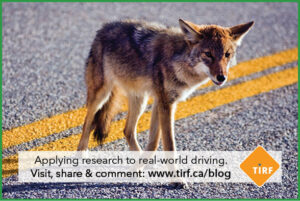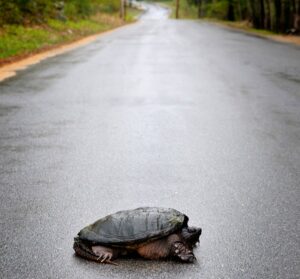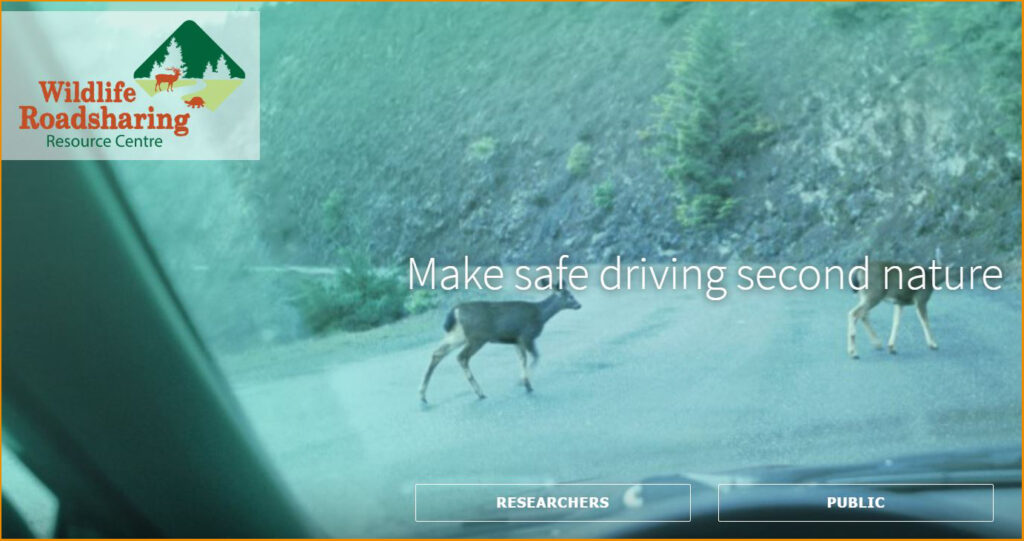With the spread of COVID-19, Spring 2020 looks quite different from years past.
As restrictions are lifting, more vehicles and people are on the road than we’ve seen in the past two months. These strategies are designed to protect everyone, particularly vulnerable populations and essential service workers.
However, the movement of wildlife continues to be predictable. At this time of year, warmer weather and better road conditions also bring an increase in wildlife-vehicle collisions, many of them resulting in injuries and fatalities. Between 2000 and 2014, there were 474 deaths due to collisions with wildlife; almost half of them (49.8%) involved moose and one-quarter (26%) involved deer.

In addition, lower speeds and alert drivers protect many smaller animals often killed on the road during Spring and Summer months; a time when new babies are being born and animals are migrating. Several species of turtles and frogs are killed in large numbers, and many of them play an essential role in our eco-system and are deemed at-risk or endangered by provincial legislation.
Strategies to help drivers reduce risks and anticipate where they may encounter wildlife can prevent avoidable collisions and ensure COVID-19 patients receive the health services they need.
Spring thaw brings the increased presence of wildlife
Spring is a busy time of year as animals begin migrating as winter ends. Large animals, such as moose, deer, and bears often frequent salt pools at the side of the road created during the spring snow melt. This means we can expect to see more of these larger animals on our roadways during this period. Large animals also prefer to travel roads, not only because they encounter fewer barriers and the landscape is flat, but the open shoulders and low grasses along the side of roads support the growth of shrubs which are an important food source for deer and moose. As a result, traveling deer and moose can often be spotted beside or even on roads, meaning these larger animals are regularly involved in wildlife-vehicle collisions.

Reduced road traffic may influence animal behaviours

There are a number of prevention technologies advertised to scare animals away. Specifically, deer whistles promise the high-pitched sounds created by the air passing through them as a result of the vehicle’s speed will scare the deer and stop them from coming onto the road. These whistles have not been proven to be effective and in some cases, the deer will even run towards the noise to see what it is. It’s also important to note that many animals don’t associate the sound of vehicles with danger. The most effective method of prevention is to stay alert, drive within the posted speed limit, pay attention to surroundings, and remember that animal movements are unpredictable.
What to do if you see small wildlife on the road

What to do if you see LARGE wildlife on the road
Now, it’s a different story altogether if you see a moose on the road. In this case, the safest response is for drivers to slow down and aim their vehicle at the flanks (rear) of the moose. In aiming for the flank of the moose, it will minimize the risk of the moose sliding across the hood of the car. This is important as it may minimize the damage caused by the full weight of the moose’s upper body impacting the windshield and roof of the vehicle. Most animals are not likely to remain still and since their behaviour is unpredictable, drivers cannot anticipate which direction the animal will move. This is especially true of deer whose natural defence is to dart and zigzag to avoid predators. Therefore, swerving to avoid animals is often much more dangerous for drivers and animals, and is not recommended in most situations.
We are all certainly navigating a new normal in these challenging times, but the research behind wildlife on roads is still an important consideration for those still needing to use our community roads and highways.
More information on safely sharing the road with wildlife can be found online at TIRF’s Wildlife Roadsharing Resource Centre (WRRC) along with free downloads of fact sheets, flashcards and other helpful tools.
Say something, the life you save could be yours.
#MySafeRoadHome blog author: Hannah Barrett is a research associate at the Traffic Injury Research Foundation. She is a criminologist and specializes in alcohol ignition interlock programs, wildlife-vehicle collisions, and impaired driving countermeasures.
Source documents and resources:
Canadian wildlife-vehicle collisions: an examination of knowledge and behavior for collision prevention, 2019, Vanlaar, W. G., Barrett, H., Hing, M. M., Brown, S. W., & Robertson, R. D. https://www.ncbi.nlm.nih.gov/pubmed/30876509
Management of roadside salt pools to reduce moose-vehicle collisions, 2007, Leblond, M., Dussault, C., Ouellet, J-p., Poulin, M., Courtois, R. https://www.wildlifecollisions.ca/docs/leblondmngtsaltlicks2006.pdf
Wildlife-Vehicle Collisions: 2000-2014, 2018, Traffic Injury Research Foundation https://tirf.ca/wp-content/uploads/2017/10/WRRC-Wildlife-Vehicle-Collisions-2000-2014-Factsheet-5.pdf
Related topics:
 |
 |
 |
 |



